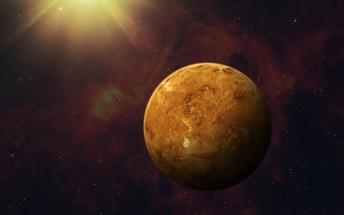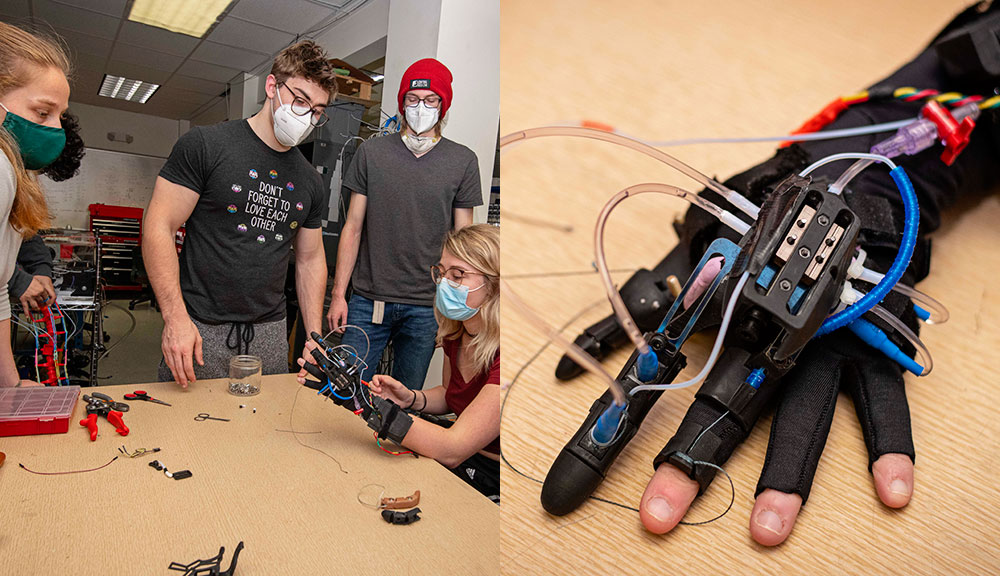What junior in college hasn’t had their head in the clouds at some point?
Max Seager
Max Seager is no different, with one big exception: for the third-year biochemistry major, those clouds are made of concentrated sulfuric acid, swirling high above the surface of Venus.
How did he get there? Seager is part of team of researchers whose recently published findings suggest that the some of the building blocks of life—here on Earth, at least—might actually be able to survive in Venus’s harsh atmosphere. These remarkable discoveries have helped motivate Morning Star Missions to Venus, a series of largely privately funded, unmanned missions to our closest neighbor in the solar system, starting with the Rocket Lab Mission to Venus in January 2025.
The team’s paper on the stability of nucleic acid bases was published last year in the Proceedings of the National Academy of Sciences (PNAS), and their paper on the stability of amino acids will be included in an upcoming issue of Astrobiology; it was also posted on an online archive.
Seager’s work on the project also led him to find a new way to connect with his mother, Sara Seager, the renowned Massachusetts Institute of Technology (MIT) astrophysicist and planetary scientist leading the research. We talked with him about his research, the prospect of finding the building blocks of life on Venus, and being able to work alongside his mother.
Talk about the work you’re involved in that has helped motivate the upcoming Rocket Lab Mission to Venus:
Seager: Big picture, we’re looking at the concept that Carl Sagan proposed years ago: could there be life in the Venus clouds? On the surface of Venus, it’s extremely hot so there’s pretty much no chance that anything could possibly survive. But in the clouds 40 to 50 kilometers above the surface, it’s approximately Earth’s temperature and pressure. So what is the possibility that there could be microbes floating in the clouds?
These clouds, however, are not made up of water, but concentrated sulfuric acid, which previously has been thought to destroy any form of complex organic molecules. We wanted to do a simple, foundational study: could these organic molecules that are the building blocks of life here on Earth be stable in sulfuric acid?
And your team’s research, published last year in the science journal PNAS and slated to be published in an upcoming issue of Astrobiology, found that these building blocks of life remained stable?
Seager: Yes, for the most part, they remain stable and intact over the span of many months.
But that doesn’t automatically prove that life exists on Venus.
Seager: As my mom always emphasizes, we’re not looking for life or trying to prove life, but we’re saying that without these simple building blocks, life—our life on Earth—couldn’t exist. Life on Earth needs water (and scientists hypothesize any potential life needs a liquid solvent), so we essentially asked: since the nucleic acid bases and the amino acids remained stable in the same concentrated sulfuric acid that exists in the clouds above Venus, could that life use sulfuric acid as a solvent instead of water? Basically, we want to study whether sulfuric acid might play the same role in supporting life on Venus that water plays in supporting life on Earth.
What role is the research going to play in the 2025 mission to Venus?
Seager: The first mission will be looking at fluorescence (and backscattered polarized radiation) as a simple test to see if there are complex organic molecules. A probe will get dropped into the atmosphere, and as it falls, we’ll have five minutes or so in the cloud layers to get readings and send them back, then the probe will implode or crash on the surface. That’s the simplest detection method. Eventually the team wants to get a sample return, but that’s far into the future. That’s a lot harder than just sending a little probe.
What was it like getting to work with your mom on this? How did it all start?
Seager: It’s super fun working with her. When I was a kid, we would be able to play sports together, but once I got older, she was afraid we weren’t going to share any hobbies. Once we started doing research together it was awesome to start to share a new interest we could collaborate on.
It started over COVID. We had nothing to do, school was remote and the sports fields were closed down. She initially got me set up just doing some basic research at home—really fundamental research on what sort of building blocks for space vehicles could survive sulfuric acid.
Then I started college and started studying biochemistry. My mom doesn’t really have a chemistry background; there are some other people on the team that do, but she told me, “We could use your help on the chemistry side of it,” and then we started on the first project, looking at nucleic acid bases. I did a little bit of work on it, some at home, some interpreting data from the lab at MIT. The amino acids research started last year, when I had broken my arm and didn’t have much to do for a few months, so we started the studies in our makeshift home lab, before transitioning the lab work to MIT, where it is now.
What brought you to WPI?
Seager: I really liked the project-based learning model at WPI—I’m still enjoying that. It’s the main thing that drew my attention, along with the IQP and MQP programs. I also like the overall STEM foundation here, and the top notch biochemistry program.
How have you applied the Venus research experience to your studies at WPI?
Seager: The main thing I learned about from working with the Venus team relates to the process of writing and publishing papers—specifically, the rigor of the submission and revision process and just how long it takes to obtain a final, peer-reviewed version of a paper for publication. Additionally, I learned a lot about the technical writing of research papers, and was able to apply some new technical writing skills to a lab report paper I had to write for a biochem lab last term, for example.
What’s next for you? Are you starting to think about graduation next year?
Seager: I haven’t thought too much about that yet. I’ll be on IQP in Cádiz next term, studying and implementing photocatalytic degradation processes of microplastics in wastewater treatment plants. As far as the research I’m involved with with my mom, we’re continuing with our experiments, expanding our future focus to more complex biomolecules. This summer I’ll be working with our Venus team and professor Destin Heilman, studying proteins and other polymers in sulfuric acid.




